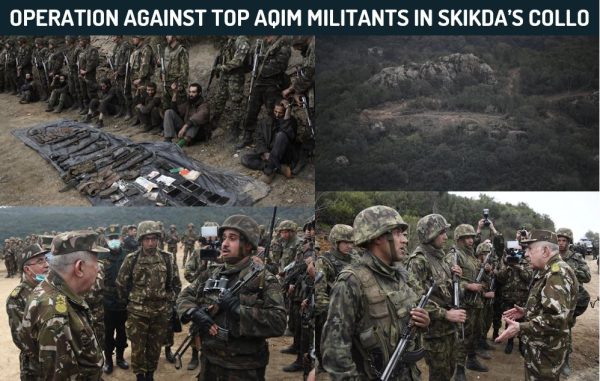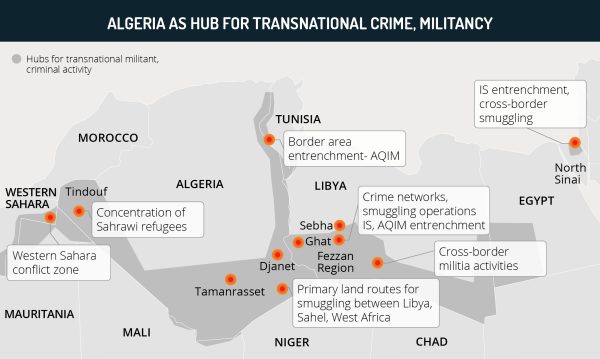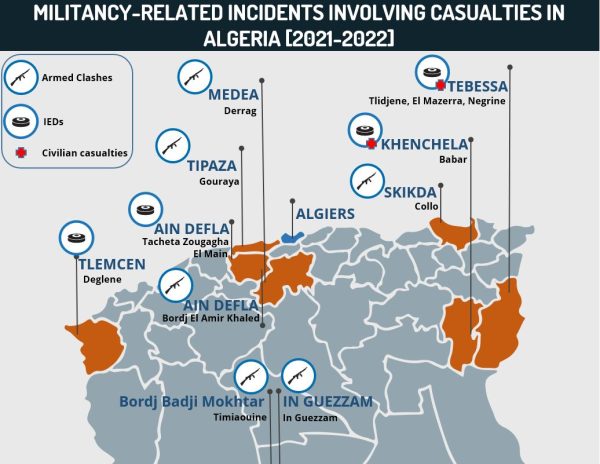04
Aug 2022
12:47 UTC
Algeria Analysis: AQIM to continue trying to regroup, restore operational capacity in Algeria, despite effective clampdown by security forces
Executive Summary:
- al-Qaeda in the Islamic Maghreb’s (AQIM) Abu Yasser al-Jazairi narrated a video message in July and called for the liberation of Algeria from “colonial power”. The publication was another indication that the group is unwilling to forsake Algeria as an arena for jihad, despite its gradual loss of capabilities in recent years amid an effective counter-militancy campaign.
- Both the effectiveness of the counter-militancy campaign and the threat posed by AQIM were demonstrated by counter-militancy operations in February-April, which resulted in the capture or death of senior operatives but also revealed that the group retains militant capabilities.
- These include the ability to seek refuge in outlying, mountainous areas, gather in relatively large cells and maintain communication channels, and their ability to acquire military-grade weapons.
- The jihadist outfit is likely to continue to dedicate efforts to reinvigorate its operational capabilities in Algeria.
- The threat presented by AQIM militants will likely continue to be confined to outlying, mountainous areas. Focal points will include areas between Ain Defla, Medea, and Tipaza, the borderlands of Tebessa and Khenchela, and In Guezzam and Bordj Badji Mokhtar in the south.
Current Situation
- On February 19, the People’s National Army (ANP) carried out an operation in the Oued Edouar Forest in Skikda Province’s Collo (near the commune of Beni Zid) and killed seven militants. The ANP seized six assault rifles, ammunition, and other items.
- In an operation on March 16 near the same locale, the ANP announced the detention of seven militants. The ANP also seized eight assault rifles, ammunition, and other items.
- The ANP’s Chief of Staff, Lieutenant General Said Chanegriha, revealed the names of the captured militants, which included Leslous Madani [Sheikh Assem Abu Hayane], ”Mufti” of AQIM and Betayeb Yousef [Osama Abu Sufiane Anighassi], an “Emir” [leader] in the outfit.
- On April 5, authorities announced the discovery of a militant cache in Tizi Ouzou Province, which was based on intelligence gathered during the arrest of AQIM operatives in Skikda on March 16. Security forces seized multiple arms, including a Strela-M2 Man-Portable Air Defense System (MANPADS), RPG launchers and projectiles, machine guns, assault rifles, and ammunition.
- In an April 6 broadcast on Algerian television, one of the captured AQIM operatives, Abu Hayane, expressed his regret for engaging in violent jihadism and called on fighters to renounce violence.
- On May 19, Abu Khalil Idrees, emir of “Algeria’s Western Region” in AQIM, announced in an audio message released through the outfit’s al-Andalus media that AQIM continues jihad in Algeria. He renounced Abu Hayane’s call to end the fight against the state and claimed that he was speaking under duress. Idrees also renewed his pledge of allegiance to AQIM’s Emir, Abu Ubaida Yussef al-Annabi.
- In a message released around July 18, AQIM’s Abu Yasser al-Jazairi released a statement marking Algeria’s Independence Day. He called to “liberate” Algeria from “colonial power” that is embodied in all the illegitimate successive Algerian governments.

Assessments & Forecast
Effective clamp down by security forces to further erode AQIM’s operational capabilities in Algeria
- AQIM’s capabilities in Algeria have been in a state of long-term gradual decline as a result of a persistent nationwide counter-militancy campaign carried out by the ANP. This is evidenced by the fact that AQIM has not claimed an attack in the country over the past two years at least, apart from confirmation that a landmine that wounded civilians in Tebessa in October 2021 was planted by the group’s militants. The effectiveness of the ANP’s campaign was underscored by the February and March operations, which resulted in several militant casualties and the detainment of several of the outfit’s senior operatives, including Abu Hayane, who were taking refuge in remote, outlying mountainous areas in Skikda with very limited access to supplies. This was corroborated by the fact that the high-ranking AQIM operatives decided to surrender, as per their own alleged confessions, following a siege that was essentially imposed by the ANP in the forest. It was also partially indicated by the fact that a militant who was wounded in March succumbed to his wounds reportedly after ten days in the same region, indicating that the militants had no operational capacity to transport the wounded operative to receive treatment.
- The fact that a network of senior AQIM figures was taking refuge in this isolated mountainous area, without supplies, further underscores the challenges the al-Qaeda affiliate is facing to remain relevant. The group seeks to preserve its Algerian heritage and parts of its command structure within Algeria, where the group is under significant pressure from security forces. This challenge is compounded by the prolonged difficulty the group faces in appealing to the local populace and gaining support and recruits. FORECAST: In this context, the latest operations are a testament to the overall success of Algerian security forces in dismantling militant cells. The broadcasting of a confession by operatives in which they admitted to having been subject to a siege before deciding to surrender, will also serve as a demoralizing factor for jihadist sympathizers to join the group. This is because of the state’s ability to publicly project it has the upper hand vis-a-vis al-Qaeda operatives, who also eventually operated contrary to what is expected from Jihadist leaders, namely, to fight to the death. Taken as a whole, the operations are thus likely to further erode AQIM’s operational capabilities within the country.
Despite effective counter-militancy campaign, AQIM’s retention of certain operational capabilities render it continued threat actor in Algeria
- Despite the above assessments, the February-April counter-militancy operations also highlighted several factors which indicate that AQIM will continue to pose at least a limited risk in Algeria. Firstly, the militants’ persistent ability to hide in some of the country’s outlying and mountainous areas, including in northern Algeria’s coastline areas, such as Skikda’s Collo. Militants are likely benefiting from the cover provided by these densely forested areas against reconnaissance by unmanned aerial vehicles (UAVs), which the Algerian military has increasingly employed in recent years. The rugged terrain hampers accessibility and reconnaissance capabilities by ground forces, often preventing the deployment of armored vehicles, and thus limiting the ANP to patrols and search operations on foot.
- The recent operations also highlighted the militants’ ability to congregate in cells of at least seven operatives, as shown by the March 16 operation in Skikda. This, in turn, suggests that the militants were able to maintain at least some form of communication channels prior to gathering in their hideouts and the ability to sustain themselves beyond the reach of Algeria’s security forces. The sustainability of the outfit’s communication channels was also highlighted in the relatively quick turnaround in which senior AQIM leaders issued audio and video messages in response to the latest counter-militancy successes. These were efforts to bolster morale among the group’s members at a time of relative crisis. Also notable was the indication that AQIM militants are able to operate as part of a broader, cross-provincial network. This was suggested by the operation that led to the detention of militants in Skikda on March 16, which facilitated the subsequent seizure of a weapons cache in Tizi Ouzou Province, approximately 250 km west of Skikda. This indicates that the militants in the latter province had shared this intelligence with the militants from the former, pointing to a larger network and the maintenance of communication channels.
- The seizure in Tizi Ouzou also reiterates the militants’ ability to acquire military-grade arms, extending to machine guns, RPG launchers, RPG projectiles [which can also be converted to IEDs], in addition to a MANPADS, which could potentially be used to target low-flying aerial targets. However, the picture released by the MDN suggests that the specific MANPADS was lacking crucial parts, namely a gripstock and a thermal battery. This suggests that the system was inoperable and thus would not have posed an imminent threat to aviation. This was also the case in additional instances over recent years in which MANPADS were found by security forces in Algeria. The operational use of such MANPADS by non-state actors has not been recorded in the region in several years. In this context, it is more likely that the MANPADS reached Algeria-based jihadists because they were inoperable and may have been disposed of by professional armies before being smuggled into militant inventories.
- The militants’ continued ability to acquire military-grade arms within Algeria is linked to several factors, the most notable of which being the vast and porous borderline between Algeria, Mali, and Niger. This region constitutes a focal point for the movement of arms smugglers and proliferators, which partly hail from the region’s Tuareg communities [spread throughout northern Mali, eastern and northern Niger, southern Algeria, and southwestern Libya]. These armed transnational smuggling syndicates, often linked to militant groups, transfer weapons and people between areas where central authorities lack governance capabilities, such as Libya and some West African nations. An exemplification of the risk that such networks pose in the Algerian context was a fire exchange between gunmen and ANP soldiers in In Guezzam, along the border with Niger, on January 27, where several soldiers were killed. This was further highlighted in another clash between ANP forces and militants in Timiaouine, approximately 400 km northwest of In Guezzam, on March 21. Algeria’s southern borderlands remain underdeveloped, poor, and disenchanted to a large extent with large segments of the border communities relying economically on cross-border illicit trade. FORECAST: This, as well as the continued instability in Algeria’s southern neighbors, will continue to facilitate cross-border arms smuggling, as well as the penetration of militants, into Algeria, enabling, in turn, militant outfits’ ability to acquire weapons and assemble IEDs across Algeria.
Prospects for AQIM’s survival in Algeria, medium-term outlook
- FORECAST: Despite the immense challenges faced by AQIM, the organization will likely continue its efforts to regroup within Algeria and project steadfastness, as was highlighted in the recent media publications by the group. This is mainly due to the symbolism of Algeria in the group’s history, The outfit emerged out of the Salafist Group for Preaching and Combat (GSPC), a faction of the Armed Islamic Group (GIA) and fought in the Algerian civil war. This is also since AQIM’s successive emirs were Algerians, including the current leader, Abu Ubaida Yusuf al-Annabi [Yazid Mubarak]. In this context, al-Annabi and AQIM’s Algerian operatives will continue to dedicate efforts to coordinate with its Sahel-linked groups and collaborators to bolster their militant capabilities within the Algerian arena, notwithstanding the significant price-tag inflicted on the group by Algerian security forces.
- FORECAST: Given the broad gradual loss of ranks by AQIM in Algeria, the militants are likely to continue to favor taking refuge in relatively remote, mountainous areas, to be able to secure themselves and preserve their ranks. Therefore, the risk that the militants will pose is likely to remain confined to such outlying areas, without a major capacity or desire to conduct large-scale attacks in major provincial cities and the country’s economic hubs, Algiers and Oran.
- FORECAST: However, to project its steadfastness and continued resolve, specifically in light of the renewed public pledge to continue jihad and other symbolic events, such as the US claim that it had killed al-Qaeda’s global leader, Ayman al-Zawahiri, on August 2, AQIM may seek to plan smaller-scale attacks over the short term. This is more likely to occur in outlying mountainous regions close to the militant hideout areas, and would be directed at symbols of the state, primarily security forces. The group will likely continue to refrain from targeting Algerian civilians indiscriminately. This is mainly because gaining popular support has been a prominent element in the group’s strategy in Algeria. However, individuals who travel to outlying mountainous areas and the country’s borderland regions will expose themselves to an elevated risk of being mistakenly targeted by jihadists, including by detonation of victim-operated IEDs, which the militants tend to plant around their hideouts. This risk was highlighted on January 17, 2021, when five civilians were killed in a landmine explosion in Tebessa’s Oued Khenig-Roum, for which AQIM assumed responsibility, stating that it was aimed to be a “defensive” measure [against security forces] rather than to target civilians.
- FORECAST: Notable security-related incidents throughout 2021-2022 [namely, events that included direct clashes with militants or IED detonations that led to casualties] suggest which areas are more likely to constitute prominent focal points for potential militant activity in Algeria, except for Skikda. These include several outlying mountainous areas spanning between Medea, Tipaza, and especially Ain Defla provinces, which could be the main area of operation of Abu Khalil Idrees’ “Algeria’s Western Region” of AQIM, located approximately 100 km southwest of Algiers. Several large-scale militancy-related incidents in Khenchela and Tebessa provinces, in which civilians were wounded in landmine detonations also indicate how these borderline provinces connecting Algeria to Tunisia’s western highlands and militant hotbeds, will continue to be of higher risk. Lastly, Algeria’s border region with Niger and Mali will continue to be a focal point for activity by both militant groups and armed transnational crime syndicates, which will continue to pose a heavy security risk.
Recommendations:
- Travel to Algiers may continue while adhering to security precautions regarding civil unrest and militancy.
- Those conducting essential business operations in the outlying areas of northern Algeria, including in the provinces surrounding Algiers, particularly Tipaza, Ain Defla, and Medea, are advised to avoid travel to the mountainous regions due to the underlying threat of militant activity in the region.
- Avoid all travel to the vicinity of Algeria’s border regions with Tunisia, Mali, Niger, and Libya due to the heightened threat of militant activity as a result of a spillover of violence from these countries.
- Contact us at [email protected] or +44 20-3540-0434 for security and travel support services.
Executive Summary:
- al-Qaeda in the Islamic Maghreb’s (AQIM) Abu Yasser al-Jazairi narrated a video message in July and called for the liberation of Algeria from “colonial power”. The publication was another indication that the group is unwilling to forsake Algeria as an arena for jihad, despite its gradual loss of capabilities in recent years amid an effective counter-militancy campaign.
- Both the effectiveness of the counter-militancy campaign and the threat posed by AQIM were demonstrated by counter-militancy operations in February-April, which resulted in the capture or death of senior operatives but also revealed that the group retains militant capabilities.
- These include the ability to seek refuge in outlying, mountainous areas, gather in relatively large cells and maintain communication channels, and their ability to acquire military-grade weapons.
- The jihadist outfit is likely to continue to dedicate efforts to reinvigorate its operational capabilities in Algeria.
- The threat presented by AQIM militants will likely continue to be confined to outlying, mountainous areas. Focal points will include areas between Ain Defla, Medea, and Tipaza, the borderlands of Tebessa and Khenchela, and In Guezzam and Bordj Badji Mokhtar in the south.
Current Situation
- On February 19, the People’s National Army (ANP) carried out an operation in the Oued Edouar Forest in Skikda Province’s Collo (near the commune of Beni Zid) and killed seven militants. The ANP seized six assault rifles, ammunition, and other items.
- In an operation on March 16 near the same locale, the ANP announced the detention of seven militants. The ANP also seized eight assault rifles, ammunition, and other items.
- The ANP’s Chief of Staff, Lieutenant General Said Chanegriha, revealed the names of the captured militants, which included Leslous Madani [Sheikh Assem Abu Hayane], ”Mufti” of AQIM and Betayeb Yousef [Osama Abu Sufiane Anighassi], an “Emir” [leader] in the outfit.
- On April 5, authorities announced the discovery of a militant cache in Tizi Ouzou Province, which was based on intelligence gathered during the arrest of AQIM operatives in Skikda on March 16. Security forces seized multiple arms, including a Strela-M2 Man-Portable Air Defense System (MANPADS), RPG launchers and projectiles, machine guns, assault rifles, and ammunition.
- In an April 6 broadcast on Algerian television, one of the captured AQIM operatives, Abu Hayane, expressed his regret for engaging in violent jihadism and called on fighters to renounce violence.
- On May 19, Abu Khalil Idrees, emir of “Algeria’s Western Region” in AQIM, announced in an audio message released through the outfit’s al-Andalus media that AQIM continues jihad in Algeria. He renounced Abu Hayane’s call to end the fight against the state and claimed that he was speaking under duress. Idrees also renewed his pledge of allegiance to AQIM’s Emir, Abu Ubaida Yussef al-Annabi.
- In a message released around July 18, AQIM’s Abu Yasser al-Jazairi released a statement marking Algeria’s Independence Day. He called to “liberate” Algeria from “colonial power” that is embodied in all the illegitimate successive Algerian governments.

Assessments & Forecast
Effective clamp down by security forces to further erode AQIM’s operational capabilities in Algeria
- AQIM’s capabilities in Algeria have been in a state of long-term gradual decline as a result of a persistent nationwide counter-militancy campaign carried out by the ANP. This is evidenced by the fact that AQIM has not claimed an attack in the country over the past two years at least, apart from confirmation that a landmine that wounded civilians in Tebessa in October 2021 was planted by the group’s militants. The effectiveness of the ANP’s campaign was underscored by the February and March operations, which resulted in several militant casualties and the detainment of several of the outfit’s senior operatives, including Abu Hayane, who were taking refuge in remote, outlying mountainous areas in Skikda with very limited access to supplies. This was corroborated by the fact that the high-ranking AQIM operatives decided to surrender, as per their own alleged confessions, following a siege that was essentially imposed by the ANP in the forest. It was also partially indicated by the fact that a militant who was wounded in March succumbed to his wounds reportedly after ten days in the same region, indicating that the militants had no operational capacity to transport the wounded operative to receive treatment.
- The fact that a network of senior AQIM figures was taking refuge in this isolated mountainous area, without supplies, further underscores the challenges the al-Qaeda affiliate is facing to remain relevant. The group seeks to preserve its Algerian heritage and parts of its command structure within Algeria, where the group is under significant pressure from security forces. This challenge is compounded by the prolonged difficulty the group faces in appealing to the local populace and gaining support and recruits. FORECAST: In this context, the latest operations are a testament to the overall success of Algerian security forces in dismantling militant cells. The broadcasting of a confession by operatives in which they admitted to having been subject to a siege before deciding to surrender, will also serve as a demoralizing factor for jihadist sympathizers to join the group. This is because of the state’s ability to publicly project it has the upper hand vis-a-vis al-Qaeda operatives, who also eventually operated contrary to what is expected from Jihadist leaders, namely, to fight to the death. Taken as a whole, the operations are thus likely to further erode AQIM’s operational capabilities within the country.
Despite effective counter-militancy campaign, AQIM’s retention of certain operational capabilities render it continued threat actor in Algeria
- Despite the above assessments, the February-April counter-militancy operations also highlighted several factors which indicate that AQIM will continue to pose at least a limited risk in Algeria. Firstly, the militants’ persistent ability to hide in some of the country’s outlying and mountainous areas, including in northern Algeria’s coastline areas, such as Skikda’s Collo. Militants are likely benefiting from the cover provided by these densely forested areas against reconnaissance by unmanned aerial vehicles (UAVs), which the Algerian military has increasingly employed in recent years. The rugged terrain hampers accessibility and reconnaissance capabilities by ground forces, often preventing the deployment of armored vehicles, and thus limiting the ANP to patrols and search operations on foot.
- The recent operations also highlighted the militants’ ability to congregate in cells of at least seven operatives, as shown by the March 16 operation in Skikda. This, in turn, suggests that the militants were able to maintain at least some form of communication channels prior to gathering in their hideouts and the ability to sustain themselves beyond the reach of Algeria’s security forces. The sustainability of the outfit’s communication channels was also highlighted in the relatively quick turnaround in which senior AQIM leaders issued audio and video messages in response to the latest counter-militancy successes. These were efforts to bolster morale among the group’s members at a time of relative crisis. Also notable was the indication that AQIM militants are able to operate as part of a broader, cross-provincial network. This was suggested by the operation that led to the detention of militants in Skikda on March 16, which facilitated the subsequent seizure of a weapons cache in Tizi Ouzou Province, approximately 250 km west of Skikda. This indicates that the militants in the latter province had shared this intelligence with the militants from the former, pointing to a larger network and the maintenance of communication channels.
- The seizure in Tizi Ouzou also reiterates the militants’ ability to acquire military-grade arms, extending to machine guns, RPG launchers, RPG projectiles [which can also be converted to IEDs], in addition to a MANPADS, which could potentially be used to target low-flying aerial targets. However, the picture released by the MDN suggests that the specific MANPADS was lacking crucial parts, namely a gripstock and a thermal battery. This suggests that the system was inoperable and thus would not have posed an imminent threat to aviation. This was also the case in additional instances over recent years in which MANPADS were found by security forces in Algeria. The operational use of such MANPADS by non-state actors has not been recorded in the region in several years. In this context, it is more likely that the MANPADS reached Algeria-based jihadists because they were inoperable and may have been disposed of by professional armies before being smuggled into militant inventories.
- The militants’ continued ability to acquire military-grade arms within Algeria is linked to several factors, the most notable of which being the vast and porous borderline between Algeria, Mali, and Niger. This region constitutes a focal point for the movement of arms smugglers and proliferators, which partly hail from the region’s Tuareg communities [spread throughout northern Mali, eastern and northern Niger, southern Algeria, and southwestern Libya]. These armed transnational smuggling syndicates, often linked to militant groups, transfer weapons and people between areas where central authorities lack governance capabilities, such as Libya and some West African nations. An exemplification of the risk that such networks pose in the Algerian context was a fire exchange between gunmen and ANP soldiers in In Guezzam, along the border with Niger, on January 27, where several soldiers were killed. This was further highlighted in another clash between ANP forces and militants in Timiaouine, approximately 400 km northwest of In Guezzam, on March 21. Algeria’s southern borderlands remain underdeveloped, poor, and disenchanted to a large extent with large segments of the border communities relying economically on cross-border illicit trade. FORECAST: This, as well as the continued instability in Algeria’s southern neighbors, will continue to facilitate cross-border arms smuggling, as well as the penetration of militants, into Algeria, enabling, in turn, militant outfits’ ability to acquire weapons and assemble IEDs across Algeria.
Prospects for AQIM’s survival in Algeria, medium-term outlook
- FORECAST: Despite the immense challenges faced by AQIM, the organization will likely continue its efforts to regroup within Algeria and project steadfastness, as was highlighted in the recent media publications by the group. This is mainly due to the symbolism of Algeria in the group’s history, The outfit emerged out of the Salafist Group for Preaching and Combat (GSPC), a faction of the Armed Islamic Group (GIA) and fought in the Algerian civil war. This is also since AQIM’s successive emirs were Algerians, including the current leader, Abu Ubaida Yusuf al-Annabi [Yazid Mubarak]. In this context, al-Annabi and AQIM’s Algerian operatives will continue to dedicate efforts to coordinate with its Sahel-linked groups and collaborators to bolster their militant capabilities within the Algerian arena, notwithstanding the significant price-tag inflicted on the group by Algerian security forces.
- FORECAST: Given the broad gradual loss of ranks by AQIM in Algeria, the militants are likely to continue to favor taking refuge in relatively remote, mountainous areas, to be able to secure themselves and preserve their ranks. Therefore, the risk that the militants will pose is likely to remain confined to such outlying areas, without a major capacity or desire to conduct large-scale attacks in major provincial cities and the country’s economic hubs, Algiers and Oran.
- FORECAST: However, to project its steadfastness and continued resolve, specifically in light of the renewed public pledge to continue jihad and other symbolic events, such as the US claim that it had killed al-Qaeda’s global leader, Ayman al-Zawahiri, on August 2, AQIM may seek to plan smaller-scale attacks over the short term. This is more likely to occur in outlying mountainous regions close to the militant hideout areas, and would be directed at symbols of the state, primarily security forces. The group will likely continue to refrain from targeting Algerian civilians indiscriminately. This is mainly because gaining popular support has been a prominent element in the group’s strategy in Algeria. However, individuals who travel to outlying mountainous areas and the country’s borderland regions will expose themselves to an elevated risk of being mistakenly targeted by jihadists, including by detonation of victim-operated IEDs, which the militants tend to plant around their hideouts. This risk was highlighted on January 17, 2021, when five civilians were killed in a landmine explosion in Tebessa’s Oued Khenig-Roum, for which AQIM assumed responsibility, stating that it was aimed to be a “defensive” measure [against security forces] rather than to target civilians.
- FORECAST: Notable security-related incidents throughout 2021-2022 [namely, events that included direct clashes with militants or IED detonations that led to casualties] suggest which areas are more likely to constitute prominent focal points for potential militant activity in Algeria, except for Skikda. These include several outlying mountainous areas spanning between Medea, Tipaza, and especially Ain Defla provinces, which could be the main area of operation of Abu Khalil Idrees’ “Algeria’s Western Region” of AQIM, located approximately 100 km southwest of Algiers. Several large-scale militancy-related incidents in Khenchela and Tebessa provinces, in which civilians were wounded in landmine detonations also indicate how these borderline provinces connecting Algeria to Tunisia’s western highlands and militant hotbeds, will continue to be of higher risk. Lastly, Algeria’s border region with Niger and Mali will continue to be a focal point for activity by both militant groups and armed transnational crime syndicates, which will continue to pose a heavy security risk.
Recommendations:
- Travel to Algiers may continue while adhering to security precautions regarding civil unrest and militancy.
- Those conducting essential business operations in the outlying areas of northern Algeria, including in the provinces surrounding Algiers, particularly Tipaza, Ain Defla, and Medea, are advised to avoid travel to the mountainous regions due to the underlying threat of militant activity in the region.
- Avoid all travel to the vicinity of Algeria’s border regions with Tunisia, Mali, Niger, and Libya due to the heightened threat of militant activity as a result of a spillover of violence from these countries.
- Contact us at [email protected] or +44 20-3540-0434 for security and travel support services.





